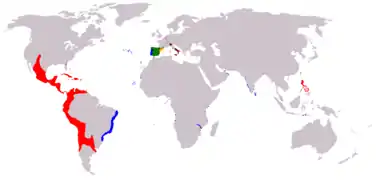Supreme Council of Flanders
The Supreme Council of Flanders (Consejo Supremo de Flandes y Borgoña, or simply Consejo de Flandes) was a governing institution in the Spanish Empire responsible for advising the king of Spain on the exercise of his prerogatives in the Spanish Netherlands, particularly regarding ecclesiastical nominations, the appointment of high officials, royal pardons, and awards of honours such as knighthoods and noble titles.[1]

History
The Supreme Council of Flanders was first founded in 1588, under Philip II of Spain, but was disbanded at his death, when the sovereignty of the Spanish Netherlands passed to Albert VII of Austria, ruling on behalf of his wife, the Infanta Isabella. The council was re-established in 1627 under Philip IV of Spain. It was finally abolished in 1702.[2]
The institution's archives are in the Archivo General de Simancas.
Membership
When reinstituted in 1627, the council was intended to consist of six members assisted by two secretaries. Three of the members were to be jurists and three members of the high nobility, with at least one member to be a native of the Low Countries and one of the noblemen acting as president. The council was very seldom effectively at full strength.[3]
President
- Diego Felipez de Guzmán, 1st Marquis of Leganés, 1628-1653
- Filippo Spinola, 2nd Marquis of the Balbases, 1653-1659
- Antonio Sancho Dávila de Toledo y Colonna, 1660-1666
Secretary
- Gabriel de Roy, knight, 1627-1645
- Jean Hernart, 1627-1631
- Juan Osvaldo de Brito, 1628-1637
- Jacques Brecht, 1638-1660
- Jean Vecquer, or Weckert, 1660-1673
Councillor
- Jean de Croÿ, Count of Solre, 1627-1640
- Pierre Roose, 1630-1632
- Jean de Gaverelles, 1633-1645
- Robert van Asseliers, 1639/40—1652
- Antoon De Vulder, 1639/40-1644
- Antoine Brun, 1642-1654
- Michel de Coxie, knight, 1652-1660
- Boudewijn Van der Piet, 1652-1658
- Aurele Augustin Van Male, 1660-1662
- Charles de Watteville, 1660-1670
- Koenraad Van der Brughen, 1661-1662
- Jean-Antoine Locquet, 1663-1669
- Jean-Baptiste de Brouchoven, Count of Bergeyck, 1663-1681
- Simon de Fierlant, 1663-1668
- Esteban de Gamarra y Contreras, 1663-1671
References
- Quintín Aldea Vaquero, Los miembros de todos los consejos de España en la decada de 1630 a 1640, Anuario de historia del derecho español, 50 (1980), p. 198.
- Annelies Vanhaelst (2002). De Hoge Raad voor de Nederlanden en Bourgondië. Leden en Bevoegdheden (1627-1665). ethesis.net (licentiate thesis). Ghent University. Introduction.
- Annelies Vanhaelst (2002). De Hoge Raad voor de Nederlanden en Bourgondië. Leden en Bevoegdheden (1627-1665). ethesis.net (licentiate thesis). Ghent University. Part 2: Prosopography.